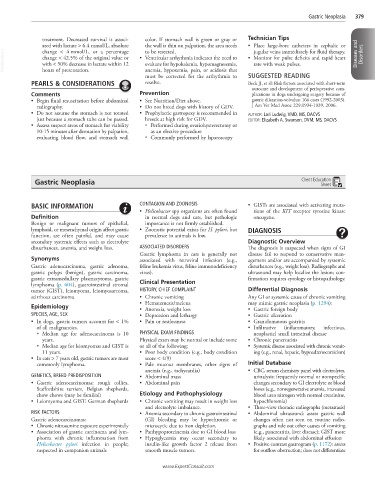Page 798 - Cote clinical veterinary advisor dogs and cats 4th
P. 798
Gastric Neoplasia 379
treatment. Decreased survival is associ- color. If stomach wall is green or gray or Technician Tips
ated with lactate > 6.4 mmol/L, absolute the wall is thin on palpation, the area needs • Place large-bore catheters in cephalic or
VetBooks.ir change < 42.5% of the original value or • Ventricular arrhythmia indicates the need to • Monitor for pulse deficits and rapid heart Diseases and Disorders
jugular veins immediately for fluid therapy.
to be resected.
change < 4 mmol/L, or a percentage
evaluate for hypokalemia, hypomagnesemia,
with < 50% decrease in lactate within 12
rate with weak pulses.
hours of presentation.
anemia, hypoxemia, pain, or acidosis that
must be corrected for the arrhythmia to SUGGESTED READING
PEARLS & CONSIDERATIONS resolve. Beck JJ, et al: Risk factors associated with short-term
outcome and development of perioperative com-
Comments Prevention plications in dogs undergoing surgery because of
• Begin fluid resuscitation before abdominal • See Nutrition/Diet above. gastric dilatation-volvulus: 166 cases (1992-2003).
radiography. • Do not breed dogs with history of GDV. J Am Vet Med Assoc 229:1934-1939, 2006.
• Do not assume the stomach is not rotated • Prophylactic gastropexy is recommended in AUTHOR: Lori Ludwig, VMD, MS, DACVS
just because a stomach tube can be passed. breeds at high risk for GDV. EDITOR: Elizabeth A. Swanson, DVM, MS, DACVS
• Assess suspect areas of stomach for viability ○ Performed during ovariohysterectomy or
10-15 minutes after derotation by palpation, as an elective procedure
evaluating blood flow, and stomach wall ○ Commonly performed by laparoscopy
Gastric Neoplasia Client Education
Sheet
BASIC INFORMATION CONTAGION AND ZOONOSIS • GISTs are associated with activating muta-
• Helicobacter spp organisms are often found tions of the KIT receptor tyrosine kinase
Definition in normal dogs and cats, but pathologic oncogene.
Benign or malignant tumors of epithelial, importance is not firmly established.
lymphoid, or mesenchymal origin affect gastric • Zoonotic potential exists for H. pylori, but DIAGNOSIS
function, are often painful, and may cause prevalence in animals is low.
secondary systemic effects such as electrolyte Diagnostic Overview
disturbances, anemia, and weight loss. ASSOCIATED DISORDERS The diagnosis is suspected when signs of GI
Gastric lymphoma in cats is generally not disease fail to respond to conservative man-
Synonyms associated with retroviral infection (e.g., agement and/or are accompanied by systemic
Gastric adenocarcinoma, gastric adenoma, feline leukemia virus, feline immunodeficiency disturbances (e.g., weight loss). Radiographs and
gastric polyps (benign), gastric carcinoma, virus). ultrasound may help localize the lesion; con-
gastric extramedullary plasmacytoma, gastric Clinical Presentation firmation requires cytology or histopathology.
lymphoma (p. 604), gastrointestinal stromal
tumor (GIST), leiomyoma, leiomyosarcoma, HISTORY, CHIEF COMPLAINT Differential Diagnosis
scirrhous carcinoma • Chronic vomiting Any GI or systemic cause of chronic vomiting
• Hematemesis/melena may mimic gastric neoplasia (p. 1294):
Epidemiology • Anorexia, weight loss • Gastric foreign body
SPECIES, AGE, SEX • Depression and lethargy • Gastric ulceration
• In dogs, gastric tumors account for < 1% • Pain or restlessness • Granulomatous gastritis
of all malignancies. • Infiltrative (inflammatory, infectious,
○ Median age for adenocarcinoma is 10 PHYSICAL EXAM FINDINGS neoplastic) small intestinal disease
years. Physical exam may be normal or include some • Chronic pancreatitis
○ Median age for leiomyomas and GIST is or all of the following: • Systemic disease associated with chronic vomit-
11 years. • Poor body condition (e.g., body condition ing (e.g., renal, hepatic, hypoadrenocorticism)
• In cats > 7 years old, gastric tumors are most score < 4/9)
commonly lymphoma. • Pale mucous membranes, other signs of Initial Database
anemia (e.g., tachycardia) • CBC, serum chemistry panel with electrolytes,
GENETICS, BREED PREDISPOSITION • Abdominal mass urinalysis: frequently normal or nonspecific
• Gastric adenocarcinomas: rough collies, • Abdominal pain changes secondary to GI electrolyte or blood
Staffordshire terriers, Belgian shepherds, losses (e.g., nonregenerative anemia, increased
chow chows (may be familial) Etiology and Pathophysiology blood urea nitrogen with normal creatinine,
• Leiomyoma and GIST: German shepherds • Chronic vomiting may result in weight loss hypochloremia)
and electrolyte imbalance. • Three-view thoracic radiographs (metastasis)
RISK FACTORS • Anemia secondary to chronic gastrointestinal • Abdominal ultrasound: assess gastric wall
Gastric adenocarcinomas: (GI) bleeding may be hypochromic or changes often not seen on routine radio-
• Chronic nitrosamine exposure experimentally microcytic due to iron depletion. graphs and rule out other causes of vomiting
• Association of gastric carcinoma and lym- • Panhypoproteinemia due to GI blood loss (e.g., pancreatitis, liver disease); GIST more
phoma with chronic inflammation from • Hypoglycemia may occur secondary to likely associated with abdominal effusion
Helicobacter pylori infection in people; insulin-like growth factor 2 release from • Positive contrast gastrogram (p. 1172): assess
suspected in companion animals smooth muscle tumors. for outflow obstruction; does not differentiate
www.ExpertConsult.com

